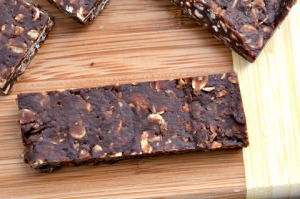Loving the BITE: The Great Oat and Intact Grains
 You’ve heard of whole grains vs. refined grains. You’ve seen the food guide pyramid with grains at the base. And now, you’ve likely heard of completely grains-free eating from Paleo and eating philosophies.
You’ve heard of whole grains vs. refined grains. You’ve seen the food guide pyramid with grains at the base. And now, you’ve likely heard of completely grains-free eating from Paleo and eating philosophies.
I’m often asked for my opinion on grains, so here it is. As with all foods, I recommend whole, real foods. I recommend that they are as intact as possible when you start with them. This isn’t a “special” philosophy for grains, but an overall philosophy for all my “Daily Nutrition” recommendations (keep in mind, Training Nutrition can be different). Of course there are exceptions, such as pure fats (oils, are only part of a whole food) – and with these isolated ingredients you must be very picky. But, for this post, stick with me on the whole, intact food theme.
I recommend whole fruits over juice.
I recommend real protein foods like meats, beans, nuts, seeds, organic soybeans, organic dairy and more over protein powders.
I recommend organic honey and real maple over syrups derived from sugar canes and rice.
I recommend whole yams, beans, and fruits for most of my carbohydrates, with optionally, a splash of whole, intact grains if you’d like. You don’t have to include grains as long as you’re getting what you need otherwise, but intact grains are a fine choice if you’d like.
What are intact grains? Let’s dive in and discuss an easy recipe for delicious granola bars while we’re at it.
Recipe of the Week: Easy Coconut-Chocolate-Oat Granola Bars
Ingredients:
- 1/2 cup natural almond butter, peanut butter, sunflower butter, or other nut/seed butter
- 1/4 cup local honey or real maple
- 1/4 cup organic coconut oil, unsalted butter or coconut oil
- 1 cup oats (not quick oats)
- 1/2 cup chopped nuts, hemp seeds, sunflower seeds, or any combination of these
- 2 tablespoons chia seeds or ground flaxseed
- 1/4 cup coconut
- 1/2 cup 70%+ cocoa chocolate chips
Instructions:
Melt the butter or coconut oil, peanut butter and honey in a pot over medium to low heat, stirring constantly. Add chia seeds or flaxseeds. Turn off the burner when melted. Pour in the oats, coconut, and chocolate chips. Stir til combined.
Pour into foil-lined 8 X 8 pan and stick in the fridge. Once cooled, flip out (the bars….not you) onto cutting board and cut to the size you like.
These can work as a breakfast, snack, or meal-replacement bar. They can also be used as pre-training fuel as long as you give them 2+ hours or so to digest well, and even during-training fuel on long rides (4+ hours)…eat every 2-3 hours or so along with other hourly fuel.
Comments:
If you didn’t already notice, grains are somewhat controversial these days. Really. There are entire books on the subject, like Wheat Belly and Grain Brain.
And, I think it’s great. While I don’t agree that everyone should be completely grain-free, I think it’s good that we’re questioning whether or not they should be the “base” of the food guide pyramid, and make up the majority of our intake. Here’s a hint: they should not.
Why? Simply, they are a high carbohydrate food that doesn’t stack up nutritionally to many other foods, such as almonds or broccoli or beans. They simply don’t. They have a place. They are an inexpensive food source, and some of them are nourishing. Many of them are not.
Within grains, there is a significant difference between refined grains, whole grains, and intact grains. And, within “carbohydrate foods” that give us similar amounts of calories of carbs, there are vast differences in nutrients (compare yams vs. wheat for example).
What’s more, over-eating “fast” or processed carbohydrates and refined grains is absolutely associated with inflammation, fat storage, and blood sugar imbalance. This is especially true when the body is sedentary.
So, should we include grains?
As long as you tolerate them, I believe “intact” grains have a place in our everyday diets. Intact grains are simply those you can see as a whole, intact grain. Wild or brown rice, oats, quinoa (sometimes considered a seed), sprouted grains, etc. If you are at your goal weight, you can include carbohydrates and these grains as much as you’d like. If not, then moderation is important for everyday carbs while you’re working towards it.
Oats specifically have a lot of good stuff for our bodies. Stuff like:
- beta-glucan, a unique and special fiber that reduces cholesterol levels, helps prevent heart disease, and significantly enhances the human immune system’s response to bacterial infection. Beta-glucan not only helps neutrophils (the most abundant type of non-specific immune cell) navigate to the site of an infection more beta-glucan has beneficial effects in diabetes.
- unique oat antioxidants, called avenanthramides, that help prevent free radicals from damaging LDL cholesterol, and therefore reduce risk of cardiovascular disease
- fibers that provide significant cardiovascular and anti-breast cancer benefits for postmenopausal women
- lignans that protect against heart disease. These lignans are converted by friendly bacteria in our intestines into mammalian lignans that is thought to protect against breast and other hormone-dependent cancers as well as heart disease.
Want to include grains in your diet? Include oats. While I may still tell you that vegetables, and not grains should be the base of your diet, oats among other intact grains can certainly play a big role. And, as you know, I’d never recommend pedaling a bike on vegetables! Oats on the other hand, can be great fuel for pre-training and during training nutrition.
Be choosy when choosing grains. Stay well and keep on pedaling this week!
Fuel Your Ride. Nourish Your Body.


